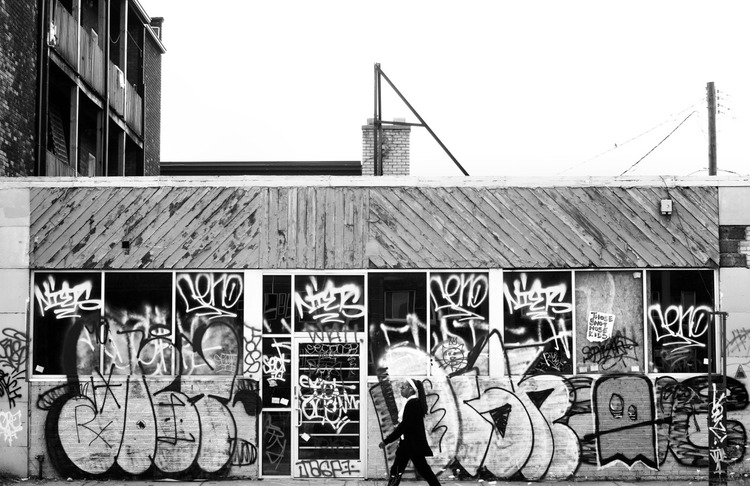© 2014 Karpov
THE RISE OF SWAT &
THE FAILINGS OF VICE
//mark jay
If you live in a city with a population greater than 50,000, there’s a 90% chance that your city boasts its own personal Special Weapons and Tactics (SWAT) unit. [1] These units, armed to the teeth with sniper rifles, ballistic shields, and armored rescue vehicles, are perhaps most famous for a four-hour-long shootout with the Black Panthers on the streets of Los Angeles in 1974. Or for the specialized unit led by Samuel L. Jackson and LL Cool J that took down a notorious French drug lord after his elaborate escape from prison. But SWAT units are deployed more than 100 times daily across the US; surely their day-to-day operations are not so glamorous. [2]
A recent article in VICE Magazine by Allie Gross discussed the impacts of one of these SWAT deployments: a 150-officer paramilitary raid on the Colony Arms apartment complex on Detroit’s East Side. In preparing the article, Gross met with Darren Reese-Brown and me, co-authors of another article about last November’s raid. During a three-hour interview with Gross, Reese-Brown — a native Detroiter, a former resident of Colony Arms, and a published author — had a lot to say about policing in Detroit.
But rather than taking the opportunity to inject a voice as critical as Reese-Brown’s into the conversation about how police affected his life, Gross omitted his quotes entirely. Instead, she used her own words to tell his story for him. The result was another stripped down, pitiable tale about voiceless victims from Detroit.
Gross wrote that Reese-Brown's fiancé, Cassandra Grimes, was pregnant for more than eight months when heavily armed officers entered her apartment during the raid. Reese-Brown, said to have formerly served time in prison, hid from the police while they interrogated Grimes. After identifying her by her bridge card, they relayed her name via walkie-talkie, and searched her name through their system. This search revealed that she had an outstanding ticket for the possession of a paltry amount of marijuana, and she was arrested.
But, in addition to omitting Reese-Brown's and Grimes' voices, and presenting a version of Grimes' story that was entirely devoid of context, VICE's account of the day of the raid was also not entirely accurate. The police came to her room with the intention of arresting Grimes - her name did not have to be walkie-talkied, nor did her name have to be run through the police's system in order for the police to learn about her outstanding ticket. Additionally, key biographical information about Grimes and Reese-Brown is garbled: Cassandra's name was misspelled twice, and Darren was incorrectly identified as having served time in prison. Five weeks ago, when I brought all of this to the attention of the editor of the article, she promised to have the facts corrected. To date, the article remains unchanged.
© 2014 Karpov
Gross wants us to understand SWAT-assisted, paramilitary raids like the one at Colony Arms as evidence of a larger police strategy of “broken windows policing” that is coming to Detroit. This strategy – birthed by the Manhattan Institute, a conservative think tank, and made famous by NYC Police Commissioner Bratton during the 1990s – entails a “zero tolerance” crackdown on petty crimes in order to prevent more serious crimes from blossoming. And this style of policing is notorious for harassing and harming poor people and minorities at disproportionate rates. [3]
But, according to her article, this NYPD strategy is also “credited with lowering the city’s crime rates.” So, there's a dilemma: on the one hand you have a police strategy that leads to absurd, racialized, and tragic results (i.e. the above story about Grimes), and on the other hand, you have a strategy that reduces crime. Gross hopes that we have it in our hearts to see that the former is more important than the latter.
However, the choice between crime-reduction and racist policing is a false one. It’s a long debunked claim that aggressive policing in NYC was to credit for the city’s drop in crime. San Diego, a city that implemented a community policing strategy during the 1990s that was pretty much the antithesis of broken windows, saw a similar drop in crime. In fact, throughout the '90s, crime dropped in many US cities that utilized less aggressive police tactics. Sustained deep poverty – not lenient policing – has been proven to be the largest harbinger of crime. [4] In other words, according to UC Berkeley sociologist Loïc Wacquant, you won’t find many respected academics – outside of those on the Manhattan Institute’s payroll – that credit broken windows policing for NYC’s crime drop.
By brushing over the facts, and by making martyrs of the victims of broken windows policing, the VICE article failed to address the real causes and effects of hyper-aggressive policing.
Towards the end of the 20th century, there were three relevant developments in the US. Firstly, social spending was reduced drastically. From 1970-1995, aid to dependent families was cut by 48% in constant dollars; the percentage of jobless Americans covered by unemployment insurance dropped to 36%; and the number of Americans in deep poverty more than doubled. While the NYPD’s budget ballooned by 40% during the ‘90s to reach $2.6 billion, the city’s schools and medical centers received a budget cut of nearly ⅓. [5]
The second development was the historically unprecedented rise in America’s incarcerated population. In 1975, there were 379,393 Americans behind bars. By 2000, that number had jumped to 1,931,850. Presently, there are more than 2.3 million prisoners and over 4 million parolees in the US (these numbers don’t include those in juvenile detention centers or military prisons). More than ⅔ of today’s inmates come from families with an income that is less than half the federal poverty line, and the vast majority are nonviolent offenders. [6]
And the prison boom cannot be blamed solely on conservatives: just as Bill Clinton was promising to end the “era of big government” by slashing funds for public housing and capping welfare benefits at five years, he oversaw the single most expensive prison construction project in US history: 213 public penitentiaries were built with taxpayer money between 1992 and 1997. Despite all these expenditures, there is no link between higher incarceration rates and lower crime rates. [7]
© 2014 Karpov
Meanwhile, as social programs were being gutted and the prison population was exploding, police forces were being bolstered. After a 1981 exemption to the Posse Comitatus Act, military personnel and equipment were allowed to be used by local police departments in order to combat the smuggling and sale of of illicit drugs. Federal subsidies like the Pentagon Giveaway Program were then put in place, sending millions of pieces of military equipment to local police departments each year, and incentives tied departments' funding to their number of drug arrests. The result is that SWAT teams began raiding impoverished areas across the US: in the early '80s, there were 3,000 SWAT deployments; by 2001 there were 40,000; and, presently, there are more than 50,000 SWAT deployments each year. Nearly 70% of these SWAT missions were drug raids. [8] Despite all this, the proliferation of SWAT units cannot account for any significant reduction in drug-related crime.
It would be easy to dismiss the decisions to spend billions of dollars on prisons and police while social services are being pruned as short-sighted and ineffective. But there are practical reasons for these policies. As capital and people fled cities like Detroit in the second half of the 20th century, governments had to adapt. Rather than spend money to vitalize social services, it became more politically acceptable (with a majority white and middle-class electorate) for the federal government to blame marginalized people’s poverty on themselves. Social explanations linking poverty to crime came to be seen as excuses. As George Bush Sr. said, “I, like most Americans, believe that we can start building a safer society by first agreeing that society itself doesn’t cause the crime–criminals cause crime.” [9]
The national debt is now approaching $18 trillion. The number of Americans living in extreme poverty is growing each year. Stable jobs for lower-class Americans are sparse. The cries for austerity are persistent and shrill. It’s easy to see a contradiction in liberal NYC mayor Bill De Blasio’s decision to rehire Bill Bratton, long-time advocate of broken windows policing, as his police chief; it’s also easy to say that Detroit Police Chief James Craig’s deployment of paramilitary raids contradicts his stated strategy of “community policing.” But, instead of a contradiction, can’t we instead see a consequence? The bolstering of America’s police forces has never been about lowering crime; it’s about dealing with the effects brought on by decades of neglectful and antagonistic policies towards poor Americans.
It matters little that broken windows policing and higher incarceration rates don’t reduce crime, nor is it overly important that the tens of thousands of SWAT units sent on drug raids each year don’t reduce drug dealing. Aggressive policing, SWAT units, and the construction of more and more jails are still relatively cheap and politically palatable ways for the government to deal with the visible manifestations of poverty.
VICE’s article basically asks us to pity those most directly affected by police aggression. But pity isn’t going to change anything. Police are only going to stop harassing marginalized Americans when there exists the political will for policies that address the causes of poverty, and not only its symptoms.
//Mark Jay is a co-founder of The Periphery.
Sources:
[1] http://object.cato.org/sites/cato.org/files/pubs/pdf/balko_whitepaper_2006.pdf
[2] http://www.economist.com/news/united-states/21599349-americas-police-have-become-too-militarised-cops-or-soldiers
[3] Prisons of Poverty. Loïc Wacquant. 2009.
[4] Punishing the Poor. Loïc Wacquant. 2009.
[5] Prisons of Poverty. Loïc Wacquant. 2009. P. 16-56
See Also: Punishing the Poor. Loïc Wacquant. 2009. P. 153.
[6] Punishing the Poor. Loïc Wacquant. 2009. P 115.
See Also: Prisons of Poverty. Loïc Wacquant. 2009. P. 63 See Also: "Correctional Population in the United States, 2010".
[7] Prisons of Poverty. Loïc Wacquant. 2009. P. 69
See Also: Punishing the Poor. Loïc Wacquant. 2009. P. 360 - Footnote 7.
[8] http://www.salon.com/2014/08/14/one_nation_under_swat_how_americas_police_became_an_occupying_force_partner/ Also: http://object.cato.org/sites/cato.org/files/pubs/pdf/balko_whitepaper_2006.pdf
[9] http://books.google.com/books?id=8TNruuq59ZIC&pg=PA158&lpg=PA158&dq=%22by+first+agreeing+that+society+itself+doesn’t+cause+the+crime–criminals+cause+crime.”&source=bl&ots=NHVNK9kh-h&sig=UOZBz8mg37tgCCqfJ2UEiUgvuOY&hl=en&sa=X&ei=p7hOVPaFHZKpyATT5oDADw&ved=0CB4Q6AEwAA#v=onepage&q=%22by%20first%20agreeing%20that%20society%20itself%20doesn’t%20cause%20the%20crime–criminals%20cause%20crime.”&f=false




